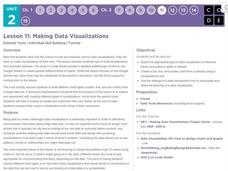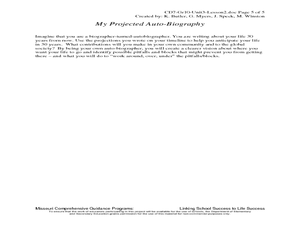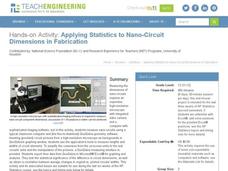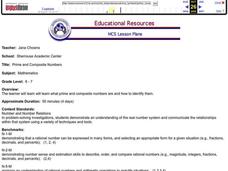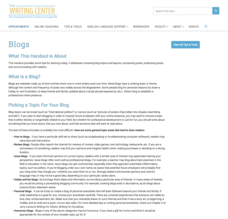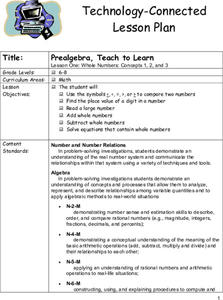Curated OER
What's Wrong With This Computer?
Young scholars, while in the computer lab, view a PowerPoint Presentation that addresses routine hardware and software problems that may occur with everyday usage of a computer. They identify and solve routine problems by checking...
Curated OER
Working With Start Up Options
In this technology worksheet, pupils practice the process of starting up the network and individual computers while using the skill of troubleshooting.
Code.org
Minecraft Hour of Code
Devote an hour to computer coding ... it's time well spent! The activity has young computer scientists write code to solve puzzles in the Minecraft game. They learn how to apply block codes and repeat loops.
Curated OER
Troubleshooting
Fifth graders in computer classes should be able to troubleshoot some common errors that they will encounter on a day to day basis and solve basic connectivity issues. In this lesson they discover some of these troubleshooting skills...
Curated OER
Computer Trouble?
Fifth graders, while in the computer lab, view a PowerPoint presentation on troubleshooting problems with a computer. They are guided through some common problems that fifth graders may encounter and should be able to solve prior to...
Code.org
Making Data Visualizations
Relax ... now visualize the data. Introduce pupils to creating charts from a single data set. Using chart tools included in spreadsheet programs class members create data visualizations that display data. The activity encourages...
Curated OER
Technology: Troubleshooting Equipment
Students observe a Powerpoint presentation describing troubleshooting procedures for school technology. In the presentation, they discover how to uncover problems with hardware and software. Among the procedures addressed are adding...
Code.org
APIs and Using Functions with Parameters
Introduce your class to the API, a reference guide that lists and explains the functionality of programming language. Using JavaScript, individuals draw complex designs that require additional commands and parameters defined in the API...
Code.org
Looping and Random Numbers
Repetition, repetition, repetition. Get your class to efficiently repeat a section of code over and over again by introducing looping. Class members learn looping to quickly recreate objects they want to appear more than once in their...
Curated OER
Children's Picture Books
Fifth graders will enhance their typing skills and practice using Pages, a software for Mac computers, by writing their own children's book. Note: This lesson plan refers to a template that is not included, however, you can adapt this...
Curated OER
Past, Present, and Future: Career Exploration and Planning
Tenth graders write an autobiography about their future. For this career education lesson, 10th graders write about the future based on their career goals. Students troubleshoot possible obstacles to fulfilling a life or career dream...
Teach Engineering
Applying Statistics to Nano-Circuit Dimensions in Fabrication
Do flexible circuits change dimensions during fabrication? Groups use GeoGebra software to measure the length of pictures of flexible nano-circuits. To determine if the circuits change dimensions, future engineers use Microsoft Excel to...
Teach Engineering
Creepy Silly Putty
It might be silly to determine the creep rate of putty but groups will enjoy making different formulations of silly putty and playing with them to understand how the different mixtures behave. The second part of the activity has groups...
Teach Engineering
Let's Get it There Fast
Are planes the best shipping method? Using maps, pupils determine the fastest mode of transportation between two cities. Given a list of items to ship, groups decide the best shipping method to finish the 18th segment of a 22-part unit.
Curated OER
Writing With Dolch
Students increase their skills in word attack, fluency, and spelling of words and research and find information on topics from the Internet. They then use the Quick Cam with the computer and will increase cooperative skills in small...
Curated OER
Engineering: Lego Cars and Light Sensors
Students build Lego cars with attached light sensors. They program the car to enter a tunnel and reverse out when it records a darker light reading.
Curated OER
Prime and Composite Numbers
Prime and composite numbers are the focus of this mathematics lesson. In it, learners practice techniques for identifying these two types of numbers. They utilize the Inspiration program to complete a task that is clearly explained, and...
University of North Carolina
Blogs
The blogosphere may be overwhelmed with content, but there's still room for unique points of view. Creating a blog that stands out, however, is the bigger challenge. A handout on blogs, part of a series of handouts on specific writing...
Curated OER
Intermediate Paragraph Correction
In this intermediate paragraph correction learning exercise, students answer questions about errors in sentences. In this multiple choice learning exercise, students answer eight questions.
Curated OER
Whole Numbers
Student are assigned one of the sections on whole numbers. After reviewing the content, they teach their assigned sections to other class mates. They publish their findings on a PowerPoint slide show to use when they teach their section.
Curated OER
Robot Gears
High schoolers build simple gear trains and record data to discover how to compute gear ratios. They investigate the definition of torque and how torque can be increased or decreased in a gear train.
Curated OER
Music With a Message
Students write a line by line analysis of a song which they feel expresses a powerful message that can change society for the better. They then present their analysis to the class in an oral report.
Curated OER
Let's Get Organized
Sixth graders identify table and each of its parts, including cell, column, row, header, and formula bar. Students then explain how tables are used to store and organize information in database, organize and categorize information...
Curated OER
Move It!
Students explore the notion that simple devices can help us move objects when an understanding of forces is applied. They apply the design process, make predictions, draw sketches, make a model and evaluate their solution.







